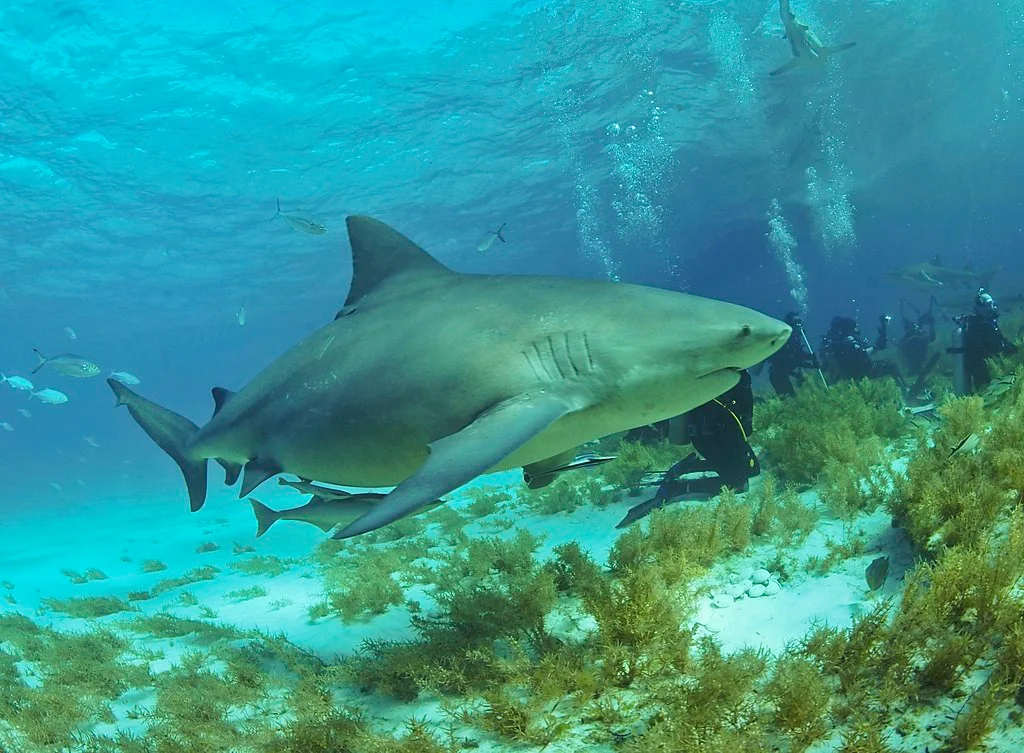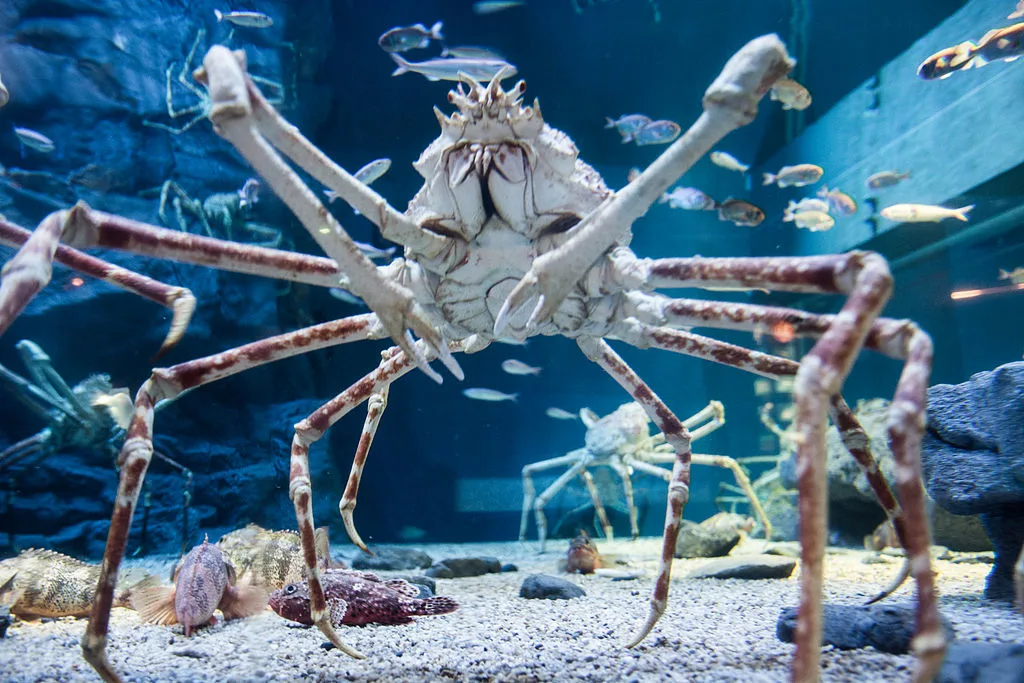
Five terrors from the deep, and why you shouldn't fear them
They're not as dangerous as they look, but we still hope they stay right where they are.
The sea is boundless, beautiful, and teeming with life. And every now and then, like in the video above, we are reminded of that some of that teeming life is enormous and, in some cases, terrifying.
Here are five such ocean-dwelling denizens that make us afraid to hit the beach.
SALTWATER CROCODILES ARE BIGGER THAN YOUR CAR
As if the ocean’s usual fare wasn’t potentially terrifying enough, we have this: The salt water crocodile, which is equally at home in the sea as it is in the river.
Common throughout southeast Asia, they’re most associated with Australia, and it's basically the reptilian poster-beast for the continent’s famously malignant fauna.
Here’s one snatching an Australian fisherman's catch:
The idea of one of these guys snatching someone off a boat and dragging them off to be devoured is not at all far fetched. That happened in 2014, when a 62-year-old man was taken. Police in Australia’s Northern Territory later shot a crocodile that was found to have human remains in its stomach.
National Geographic has a story of an improperly sedated one snapping off the arm of a vet in Taiwan, although the limb was reattached.
Growing to a maximum of 7 m, for the most part, it’s at the top of the food chain, dining on everything from crabs and turtles up to buffalo, monkeys and apparently the occasional shark:
We don’t know how often they’re moved to snack on the ocean’s premier predators, but it seems they can give them a run for its money.
Incidentally, that shark up there, the bull shark? It apparently came off second best against the croc, but against pretty much everything else, it’s enough of a killing machine on its own to make it onto our list.
BULL SHARKS HAVE NO PROBLEM HUNTING IN FRESH WATER
You’ll often see bull sharks on lists of the deadliest sharks. According to this source, it’s number three on the list of sharks likely to kill you unprovoked.

A bull shark in the Bahamas. Credit: Albert Kok/Wikimedia Commons.
With an estimated 93 reported unprovoked attacks since 1580, including 26 fatal, it’s not far behind the tiger and great white, and depending on your source, it might be responsible for many more. Regardless of what the stats are, The Florida Natural History Museum says the bull shark is often considered the most dangerous.
It’s not just because they’re aggressive beasties (although National Geographic says they are), but because they live in the places we, specifically, like to swim: Coastal areas, lakes and rivers.
Lakes? Rivers? Yup. The science behind it is complicated, but the bull shark has learned how to survive in freshwater environments, meaning you’re much more likely to encounter one.
They’ve been found thousands of kilometres up the Mississippi and Amazon Rivers. Its alternative name, the Zambezi shark, comes from the river in southeast Africa where they’re been known to hunt. They even haunt the waters of Lake Nicaragua.
Skip ahead in the video below to about 55 seconds in. It’s an aerial shot of a horde of them swarming off a popular beach in Alabama.
Even with all the evidence against it, we must point out: The likelihood of a shark actually attacking you is pretty low. You’re more likely to meet your maker after a fatal encounter with a bear, dog, lightning bolt, collapsing sandpit and a huge array of other causes than you are at the merciless fins of a bull shark.
Still, we can’t shake the feeling that a shark should have no business being in a river, but maybe that’s just us.
JAPANESE SPIDER CRABS LOOK LIKE THEY BELONG IN AN 'ALIEN' MOVIE
Hey, remember those face-hugger things from the ‘Alien’ films? The ones that would attach themselves to their victims’ faces?
We don’t know about you, but we were always slightly relieved that, as horrible as they were, at least they were wee little things, and anyways, it was just a movie and nothing like that existed in real life.
Um…
Yep. That long and spindly creature is none other than the Japanese spider crab. And while our fictional face-huggers were about dinner-plate sized, this beastie is enormous. The carapace alone can get up to more than a foot across, and the whole thing can measure up to 4 m from leg-tip to leg-tip.
It’s the largest crab species in the world, and its horrific size gave rise to mariners’ tales of these Cthulu-like creatures snatching sailors from over the side and dragging them down to be devoured in the depths….
…which isn’t remotely a real thing that happens. Spider crabs are pretty much harmless to humans.
Look beyond the creeping horror of the picture below to see the relatively small size of those claws.

Japanese spider crab at Kaiyukan Aquarium in Osaka, Japan. Credit: Takashi Hososhima/Wikimedia Commons.
Those are the claws of a scavenger, which is what most crabs are. The ones in the YouTube video above look formidable, but without being buoyed by the water they live in, they’re paralyzed. One specimen at an aquarium in the U.K. could stretch its comparatively weak arms out of the water, but simply couldn’t haul itself out of its tank.
We feel almost cheated. We feel like something that huge and crusty should at least pose SOME threat to people.
OARFISH LOOK LIKE SINISTER GIANT RIBBONS
Here’s another one that looks like it should be a dangerous alien freak: The oarfish.
They can get as long as 11 m or more, and are so elusive as to have taken on an almost legendary status (they may be the ones behind the old sea serpent myths). So whenever one of them washes ashore, it's usually a reason for spectacle:

Oarfish captured off the coast of San Diego. Credit: U.S. Navy/Wikimedia Commons.
Seriously, look at that thing in the picture above. Those spines, that face and that incredible length. It should be a real terror from the deep, right?
Well…no. Sadly, the natural world has disappointed us once again. First of all, as ugly as it is, this source says it doesn’t even have any visible teeth, and even if it did, it usually lives hundreds of metres down, so the chances of you being stalked by one are remote.
That’s even if it could be bothered to chase you. According to the NOAA scientist in this podcast, these beasties are actually weak swimmers, at the mercy of any strong currents they happen to get caught in.
See how the vacationers in the video below had to help one get back to its elements, and how leisurely its ‘escape’ was:
The U.S. National Oceanic and Atmospheric Administration didn’t even catch one on camera until 2001, but every now and then they'll re-enter the public imagination. Earlier this year, a spate of the creatures washing up off the coast of Japan sparked fears of a new earthquake, based on an old superstition:
COLLOSAL SQUIDS ARE LOVECRAFTIAN NIGHTMARES
They couldn’t call this species the “giant” squid, because that monicker had already been taken by another, woefully misnamed species.
Before we get into the size, we’d like you to take a look at the YouTube video below, because words don’t have quite the same impact as seeing it for yourself.
Go on. We’ll wait.
Did you see the teeth in the suckers? And the rotating hooks in its OTHER suckers? And the softball-sized beak? That’s what the colossal squid is bringing to the game even before we factor in the fact they can grow as much as 14 m.
Now, we should say: No one has actually caught one that large yet. This source says there have only been a handful of individuals hauled up since the 1925, and most of the time the only evidence of them are their undigested beaks, recovered from the bellies of sperm whales.
One specimen that was recovered whole was the huge creature below, hauled up from 1,800 m beneath the waves by people who thought they were hooking a toothfish:
In the water, it was estimated to be around 10 m, but by the time they got it to a museum in New Zealand, it had shrunk to a paltry 4.2 m.
So the good news is, they don’t spend much time at depths we’re likely to encounter them. The bad news? This source says they make up around 77 per cent of sperm whales’ diets, so there could be a LOT of them down there in the deeps.











